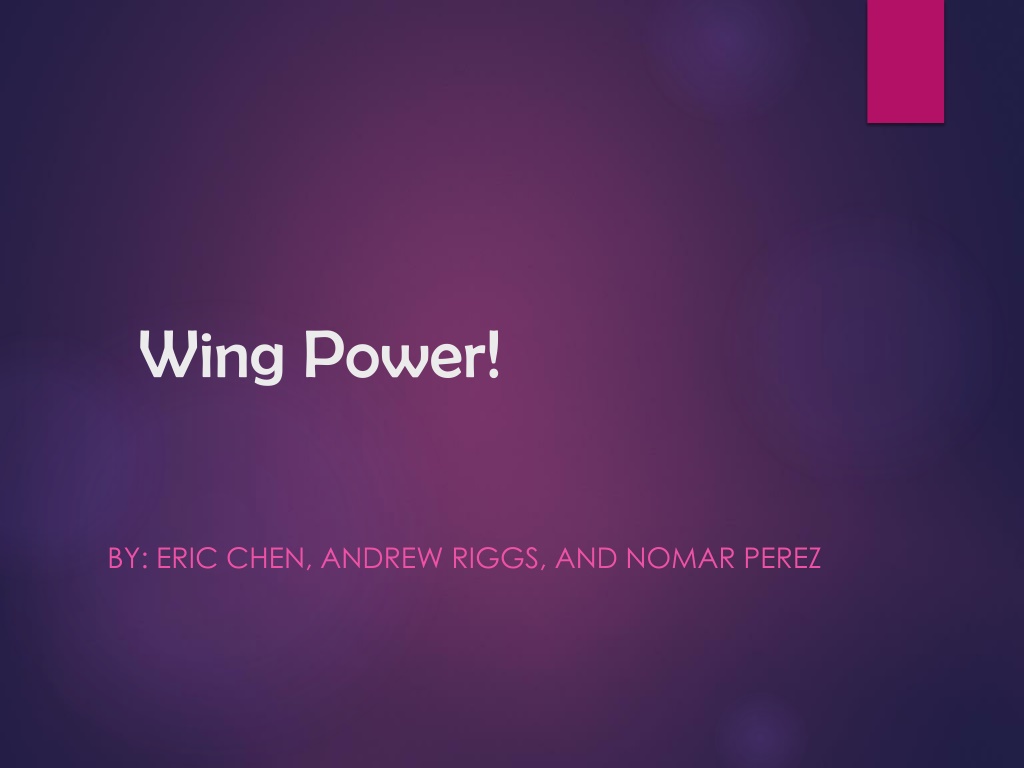Exploring the Impact of Wing Configuration on Paper Airplane Flight
Explore how changing the wing configuration of paper airplanes affects their flight distance. Learn about lift, drag, and aerodynamics, and conduct experiments to test hypotheses. The results provide insights into the role of wing design in flight performance.
Download Presentation

Please find below an Image/Link to download the presentation.
The content on the website is provided AS IS for your information and personal use only. It may not be sold, licensed, or shared on other websites without obtaining consent from the author. Download presentation by click this link. If you encounter any issues during the download, it is possible that the publisher has removed the file from their server.
E N D
Presentation Transcript
Wing Power! BY: ERIC CHEN, ANDREW RIGGS, AND NOMAR PEREZ
Question How does changing the airplane wing affect the flight of the airplane?
Background Research Lift is a component that intersects oncoming flow of direction. A drag force is also a component of force parallel to the flow of direction. Lift acts as an upward direction in order to reverse the force of gravity. If the surrounding fluid is air then a force called aerodynamic force acts upon it, and that s what lifts the plane up. Lift is a force that acts as a right angle to the direction of the air flow surrounding it. Lift is created by the air pressure. Thrust is the force that pushes a flying aircraft. According to the principle of aerodynamics fast moving air is at a lower pressure than slow moving air so the air pressure above the wing is lower than the pressure below the wing, and this creates the lift.
Bibliography Woodford, Chris. How Planes Work, Explain That Stuff, 6 Mar. 2017, explainthatstuff.com/howplaneswork.html. How Things Fly. Smithsonian National Air and Space Museum, howthingsfly.si.edu/forces-flight. Wikipedia, en.wikipedia.org/wiki/Lift-induced_drag.
Hypothesis If changing the air flow on the wings of a paper airplane affect the distance of a flight, then the upward folded wings will fly the furthest.
Materials YARDSTICK 1. COLORED PAPER 2. PENCIL 3.
Procedures First, take the paper and make three paper airplanes out of different colored paper. Then, modify two of them the first one fold the wings up. The second plane fold the wings down. Third, fly all three of the planes 3 times. Then measure how many yards each of the planes went with a yardstick. Finally, record your data.
Data The plane that has the wings up had an average of about 5 yards per throw. The plane that had the wings down had an average of about 3 and a half yards per throw. The control plane had an average of about 7 and a half yards.
Results & Interpretation The plane that went the furthest was the plane with the wings that are flat.
Conclusion In conclusion, the plane that went the farthest was the controlled airplane. Our hypothesis was wrong because we thought that the plane with the upward folded wings was going to go the farthest.























